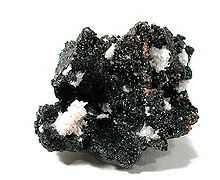Jacobsite
From Wikipedia, the free encyclopedia
| Jacobsite | |
|---|---|
 | |
| General | |
| Category |
Oxide minerals Spinel group Spinel structural group |
| Formula (repeating unit) | iron(II,III) manganese oxide, MnFe2O4 |
| Strunz classification | 04.BB.05 |
| Crystal symmetry | Isometric (4/m 3 2/m) |
| Unit cell | a = 8.457 Å; Z = 8 |
| Identification | |
| Color | Black to brownish black |
| Crystal habit | Disseminated to massive, rarely as octahedral crystals |
| Crystal system | Isometric Hexoctahedral |
| Twinning | Spinel law, flattened on {111} or lamellar |
| Cleavage | {111}, probably a parting |
| Fracture | Conchoidal |
| Mohs scale hardness | 5.5 - 6.5 |
| Luster | Metallic |
| Streak | reddish black to brown |
| Diaphaneity | Opaque |
| Specific gravity | 4.76 |
| Optical properties | Isotropic |
| Refractive index | ~�2.3 |
| References | [1][2] |
Jacobsite is a manganese iron oxide mineral. It is in the spinel group and forms a solid solution series with magnetite. The chemical formula is MnFe2O4 or with oxidation states and substitutions: (Mn2+,Fe2+,Mg)(Fe3+,Mn3+)2O4.[1][3]
It occurs as a primary phase or as alteration of other manganese minerals during metamorphism of manganese deposits.[3] Typical associated minerals include hausmannite, galaxite, braunite, pyrolusite, coronadite, hematite and magnetite.[1]
It was first described in 1869 and named for the Jakobsberg Mine, Nordmark, Filipstad, Värmland, Sweden.[2]
References

Jacobsite, N'Chwaning Mines, Kuruman, Kalahari manganese fields, Northern Cape Province, South Africa. Size 3.8 x 3.5 x 3.2 cm
| ||||||||||||||||||||||||||||
This article is issued from Wikipedia. The text is available under the Creative Commons Attribution/Share Alike; additional terms may apply for the media files.